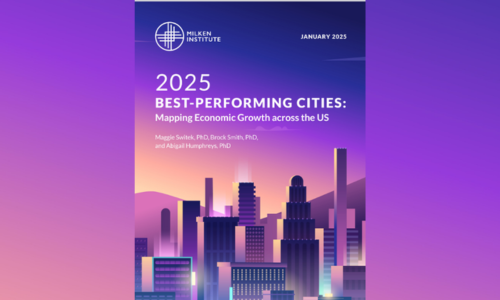
The Best-Performing Cities (BPC) index is one of the Milken Institute's flagship reports designed to provide a rigorous, data-driven assessment of the economic performance of U.S. metropolitan areas. The core idea behind the BPC index is to empower decision-makers, policymakers, local governments, business leaders, and residents with objective insights into how their cities are performing across a range of indicators tied to economic vitality. In publishing the 2025 edition of the report, the Milken Institute’s goal was twofold: first, to capture a post-pandemic snapshot of metropolitan economic recovery and transformation; second, to refine the framework to better reflect inclusive and sustainable growth.
The index, published annually since 1999, builds on decades of research and integrates 13 metrics across three major categories: labor market performance, high-tech impact, and access to economic opportunities. The measures in the report provide a comprehensive assessment of cities’ performance and the economic well-being of their residents. All data used to calculate the index are sourced from locally representative sources made available by the Bureau of Labor Statistics (BLS) and the US Census Bureau.
By providing a comparative, tiered ranking of 403 metropolitan areas, the BPC index helps stakeholders capture key trends and shifts in the US economy. Additionally, the report is accompanied by an online tool that provides an analysis of the individual components of the BPC index, offering further insights into the factors underlying the short- and medium-term performance of US metropolitan areas.
Publishing the 2025 Best-Performing Cities report combines advanced economic analysis and careful methodology. The Institute's research team set out to deliver a resource that captures insights into national trends while also providing information on each metro’s strengths and vulnerabilities. The index reflects metropolitan areas’ effectiveness at promoting employment, wages, and key industries that drive economic growth while ensuring widespread access to economic opportunities. Government officials, policymakers, and businesses can use this information to track the economic performance of cities and gain a deeper understanding of the factors underlying their performance. Additionally, businesses and city officials can use the resource to build a shared strategy that leverages cities’ strengths and sustains the long-term growth of the metropolitan areas that drive the nation’s economy.
Framework and Methodology
Milken Institute researchers began by reaffirming the integrity of our core framework, an index composed of 13 metrics drawn from reputable, publicly available sources including the Bureau of Labor Statistics and the U.S. Census Bureau. These metrics were grouped into three performance dimensions: labor market performance, high-tech impact, and access to economic opportunity. Recognizing shifts in public policy and research priorities, researchers retained income inequality and community resilience as critical components introduced in prior editions. The final weighting prioritized short- and medium-term job and wage growth while still reflecting long-term structural drivers.
Execution and Design
Milken Insitute researchers use the geographic boundaries of metropolitan statistical areas (MSAs) defined by the Office of Management and Budget (OMB) delineations adopted in April 2018. Certain MSAs are further divided into metropolitan divisions (MDs). The team defines metro areas using the smaller unit of analysis when available. The 2025 ranking includes 372 MSAs and 31 MDs, resulting in 403 metropolitan areas referred to as “cities” in the report. To account for the effect of population size on growth, the 403 metropolitan areas are divided into 200 large and 203 small cities, with separate rankings for each category. Large and small metros are further divided into five tiers based on their relative performance, with top-ranking metropolitan areas in Tier 1 and bottom-ranking metros in Tier 5.
Insight and Dissemination
The analysis paid particular attention to equity, not just growth. In addition to absolute performance, the 2025 report spotlights cities where high-tech sector growth, broadband access, and housing affordability co-exist. Notably, researchers highlighted the ascent of mid-sized metros. Unlike other rankings that rely on perception-based metrics, the BPC index is grounded in hard data and reproducible methodology. Its longevity (since 1999), evolving structure, and commitment to accessibility make it both unique and highly impactful. The report combines analytical rigor and public usability, which allows the project to bridge the gap between research and action. The publication of the report in 2025 was supported by press outreach, social media campaigns, and targeted briefings for local officials and stakeholders. Findings were featured in news coverage across national and regional outlets, amplifying the report's visibility and utility.
The 2025 Best-Performing Cities index achieved its objective of delivering an insightful, policy-relevant analysis of U.S. metropolitan economic performance during a period of recovery and realignment. The report provided a critical benchmarking tool for 403 metro areas, guiding stakeholders in understanding where and why regional economies are thriving, and where they are vulnerable. The inclusion of rising mid-sized metros in the top tiers helped broaden the national conversation beyond major urban centers. The updated online tool significantly enhanced accessibility and utility, enabling users to compare performance by size, tier, and individual metrics. Policymakers and economic development professionals are able to quickly pinpoint relevant insights tailored to their region's needs. The report is a trusted source for regional economic analysis and a go-to resource for decision-makers across sectors. By successfully integrating methodological rigor with user-focused design and dissemination, the 2025 edition met its goals of offering a timely, relevant, and influential contribution to the national discourse on inclusive growth and urban resilience.
The report’s wide accessibility, policy relevance, and emphasis on equitable growth make it a compelling example of how research reports can educate, raise awareness, and drive real-world action on pro-social economic development goals.
